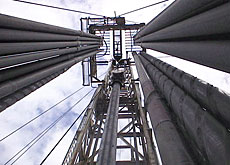
Basel turns to deep heat for energy

The city of Basel is planning to use heat from deep underground to provide 5,000 households with warmth and electricity.
But while most geothermal plants rely on naturally occurring hot springs or steam fields, engineers in Basel have been forced to adopt a different approach.
They will drill two boreholes into hot rock to a depth of five kilometres where the temperature is about 200 degrees Celsius.
They will fracture the rock between the boreholes so water can circulate. By pumping cold water down one borehole, they hope to extract hot water from the other.
Some experts believe that Hot Dry Rock (HDR) or Hot Fractured Rock (HFR) technology has enormous potential in Switzerland.
According to Markus Häring, managing director of Geothermal Explorers, as much as 30 per cent of Switzerland’s energy needs could be met in this way within 50 years.
“Geothermal energy is available round the clock,” he told swissinfo. “Unlike wind or solar power, it can produce electricity or heat all year round, day and night, whenever customers need it.”
Hole in the ground
Geothermal energy, which is free, clean and abundant, has been converted into electricity for the last 70 years.
Today more than 20 countries produce power using natural geothermal steam rising from deep wells drilled into hot permeable aquifers.
While geothermal energy is easy to access if you live on top of a hot spring or next to a geyser, development outside volcanic areas has been negligible.
The idea of mining heat from hot rock was developed by scientists in the United States in the 1970s and has been successfully trialled in the US, Japan, France, Germany and Australia.
If the Basel experiment proves successful, it will be the first time ever that energy based on this technology has been developed commercially.
Häring is optimistic because two years ago test drilling revealed temperatures of 124 degrees Celsius at depths of 2,700 metres.
A similar plant is planned for Geneva, and others sites are being investigated in canton Ticino and Central Switzerland.
In hot water
The project is expected to cost SFr80 million ($56 million) and if all goes well, it could be operational by 2008.
Canton Basel City looks set to support it to the tune of SFr40 million, which will enable drilling to start at the beginning of next year.
An additional SFr40 million will then be needed to build the power station and distribution infrastructure.
In Basel, as elsewhere, the geothermal power plant will be near the population it serves because heat cannot be transported long distances.
Not far from Basel at Soultz-sous-Forêts in Alsace, the European Union is financing the development of a similar geothermal plant.
Switzerland already has three so-called geothermal heat exchangers, which consist of a single borehole sunk into the Earth’s crust.
swissinfo, Vincent Landon
Geothermal energy has been converted into electricity for the last 70 years.
Today, more than 20 countries produce power with natural geothermal steam.
However, its development outside volcanic areas is virtually non-existent.
If the Basel project proves successful, it will be the first time ever that energy based on Hot Dry Rock technology has been developed commercially.

In compliance with the JTI standards
More: SWI swissinfo.ch certified by the Journalism Trust Initiative





























You can find an overview of ongoing debates with our journalists here . Please join us!
If you want to start a conversation about a topic raised in this article or want to report factual errors, email us at english@swissinfo.ch.